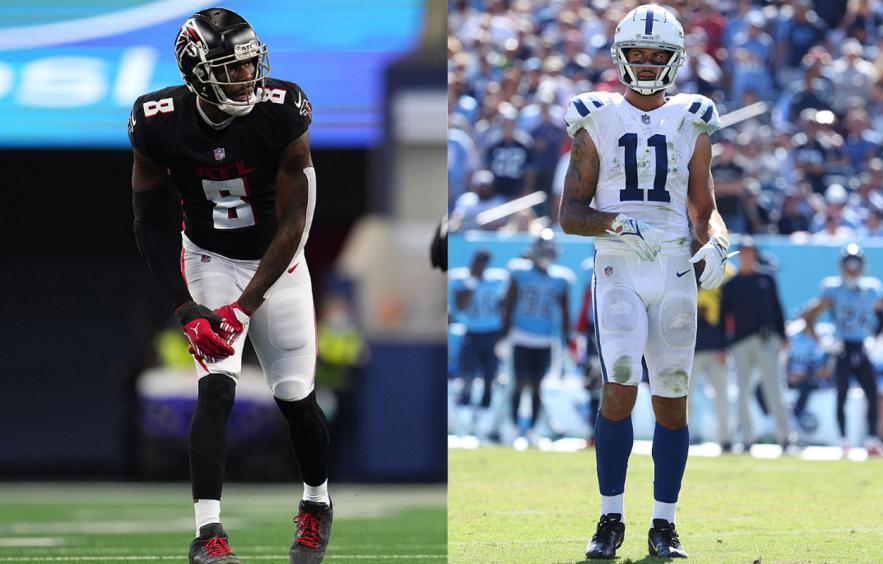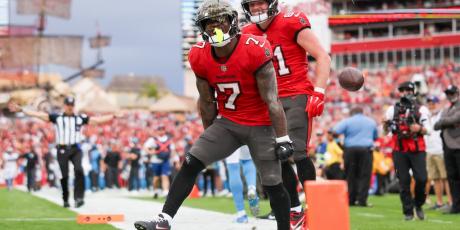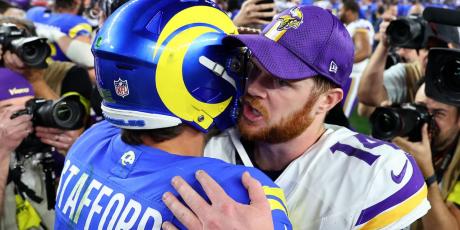Fantasy Football Debate: Kyle Pitts vs. Michael Pittman Jr.

Kyle Pitts and Michael Pittman are both being drafted in the middle of the third round of Underdog drafts, giving fantasy managers a tough decision between a potential WR1 or an elite tight end. In this debate, TJ Hernandez explains why he prefers Pitts and an early-round tight end strategy while Nic Bodiford takes the side of the Colts third-year wide receiver
Click here for more 2022 Player Profiles!
The Case for Kyle Pitts
TJ: Kyle Pitts is fairly priced with room to not only outperform his ADP but be a league-winner in the truest sense of the word. Despite coming into the NFL with borderline unreasonable first-year expectations, Pitts managed to live up to the hype—he became the only rookie tight end since the merger to gain 1,000 yards in a season, just the third to exceed 100 targets, and only the fifth to hit the 60-catch mark. He did all this with the highest average target depth among tight ends.
The one area where Pitts fell short was in the touchdown department, finding the end zone just once in 2021. If Pitts reverts anywhere close to the league average touchdown rate, his likely uptick in volume puts an overall TE1 season squarely in his range of outcomes, even with Marcus Mariota or Desmond Ridder throwing him the ball. Atlanta not only has 41% of last season’s targets up for grabs but their five-win over/under at DraftKings Sportsbook is the second-lowest total listed on the site—in other words, expect the Falcons to be behind and have to throw a lot this season.
As a rookie, Pitts absorbed 19.9% of Atlanta's targets, 28th among all players and the third-highest target share at his position. With rookie wide receiver Drake London as Pitts’ only formidable competition for targets, a target share well north of 25% for Pitts is not only viable but should probably be expected. Even with 4for4’s modest 545 projected pass attempts for the Falcons, 150+ targets are well within Pitts’ reach. Any more volume with positive touchdown regression and Pitts can blow away the field.
In a vacuum, Pitts is a great pick as the TE3 off the board. When compared to players being drafted around him, such as Michael Pittman Jr., the Falcons tight end is a slam dunk. This isn’t a knock on Pittman; consider the peripherals of Pitts and Pittman.
| Player | 2021 Yards Per Route Run* | 2021 Yards Per Target | 2021 Average Target Depth | Speed Score** | Burst Score** | Agility Score** |
|---|---|---|---|---|---|---|
| Kyle Pitts | 2.1 | 9.3 | 10.6 | 123.1 | 123.1 | 11.47 |
| Michael Pittman Jr. | 2.1 | 8.4 | 9.8 | 111.2 | 122.6 | 11.10 |
*SportsInfoSolutions **PlayerProfiler
These two players are quite similar in many ways and they are both capable of dominating in 2022, albeit in very different situations—Pitts will likely see elite target share in an offense that is forced to throw with less than ideal quarterback play while Pittman is getting a quarterback upgrade but in an offense that plays as slow as any in the league and is largely predicated on the run.
Both Pitts and Pittman have massive upside with profiles that suggest outlier years on the horizon. The decision of which player to draft comes down to opportunity and positional scarcity. Pittman is a fantastic value at his ADP but he is in a positional tier with players such as Tee Higgins, A.J. Brown, Mike Williams, and Marquise Brown who have just as much upside. With Pitts, you will be able to roster a player that offers weekly WR1 numbers that you get to use in your tight end slot.
Pittman and Pitts might both blow away their ADPs but Pitts is the 2022 roster construction cheat code.
The Case for Michael Pittman Jr.
Nic: As of mid-July 2022, Underdog Fantasy drafters are faced with a dilemma as they enter Round 3 of best ball drafts; select the ultra-talented Atlanta Falcons tight end Kyle Pitts or add the up-and-coming Indianapolis Colts X-wide receiver Michael Pittman Jr.
Like many greats before him, Pittman has succeeded despite his situation, not because of it. The 6-foot-4, 220-pound second-round pick was forced to make his transition to the pros during the onset of the COVID-19 pandemic. Three weeks into the season he nearly lost his lower leg in a battle with compartment syndrome. After emergency surgery and a month of rehabilitation, Pittman worked his way to operating as the team's clear-cut X-wide receiver and trailed veteran stalwart T.Y. Hilton by just 0.6 targets per game from Week 9 through Indianapolis' Wild Card loss to the Buffalo Bills.
Pittman quietly built on his sturdy rookie season, catching 88-of-129 targets for 1,082 receiving yards, and six touchdowns in Carson Wentz’ lone season steering Indianapolis’ ship the following year. Head coach Frank Reich had hoped to mold Indy into a pass-first team, as evidenced by their 60% neutral game script passing rate through the first eight weeks of 2021. After Wentz’ Week 8 meltdown, Reich kicked the neutral passing rate down to a Jonathan Taylor-friendly 50%. The team did, however, anoint Pittman as their passing game centerpiece, ratcheting his target market share up by five ticks to an elite 28%. The sophomore wide receiver even saw over 40% target market shares in two of the season’s final four contests.
Pittman also made strides in two of football’s most reliably predictive receiving statistics, recording 2.1 yards per route run and a 25% target per route run rate. These were promising improvements on his respective 2020 rookie year numbers of 1.6 and 19%.
While Wentz’s trebuchet occasionally made for good television, Reich envisioned a more lethal passing attack, so he ousted his quarterback and brought in long-time Atlanta signal-caller Matt Ryan. Though long in the tooth, Ryan still showed better than Wentz did last year. Both Ryan’s 73% on-target rate and his catchable ball rate of 82%. per SportsInfoSolutions, were significantly better than Wentz’s respective 67% and 78% 2021 marks.
Pittman’s benefit comes at the detriment of Atlanta tight end, Kyle Pitts. Pitts showcased one of the strongest rookie tight end performances that the NFL had ever seen last year, but he did so with Ryan at the helm. Ryan’s replacement, Marcus Mariota, failed to live up to expectations after being drafted second overall by the Tennessee Titans in 2015. Before Mariota was benched in 2019, his catchable pass rate was just 69% and his on-target rate was even worse at 66%. It’s fair to note that Mariota helped guide tight end Delanie Walker to elite TE1 finishes from 2015-2017 but those seasons are distant in the rearview.
Atlanta’s roster is riddled with holes and the only area that they really improved this offseason is Pitts’ direct competition; first-round wide receiver, Drake London. London will help pull defensive attention his way but there is a give-and-take at play with London resolutely pulling targets away from Pitts. Indianapolis’ offseason wide receiver addition comes in the form of field-stretching second-rounder, Alec Pierce. Pierce was brought in to replace the aged T.Y. Hilton and is unlikely to command a target share anywhere near London’s level.
As mentioned above, the Atlanta roster is one of the weakest in the league and the first two months of their schedule only feature two somewhat winnable games. Head coach Arthur Smith is already on the hot seat after a 4-12 inaugural campaign, which could result in a premature switch to third-round rookie quarterback Desmond Ridder. A less effective passer won’t help Pitts keep pace with the lofty point totals Pittman is primed to produce.
In order to draft Pitts, it is necessary to pass on Pittman as Pitts’ Underdog ADP of 32.5, TE3 overlaps too closely with Pittman’s 28.8, WR14. Pitts won’t disappoint; he’s a phenomenal, ascending talent. Failing to draft Pittman is a colossal error though as his range of outcomes is far greater than that of Pitts. As mentioned above, Pittman produced a targets per route run rate of 25% and a yards per route run mark of 2.1 while receiving 129 targets. There were only eight other wide receivers to match Pittman’s targets per route run, yards per route run, and clear the 100-target threshold and six of them finished as fantasy WR1s. Brandin Cooks and Pittman were WR2s and A.J. Brown was a WR3. Of the wide receivers being drafted outside of the position’s top 12, Pittman is the single best bet to contend for an elite WR1 finish. Draft him aggressively at his current 28.8, WR14 ADP.

















